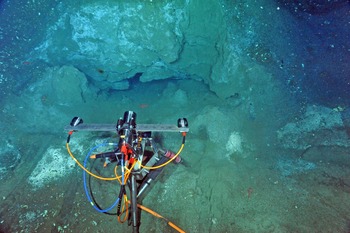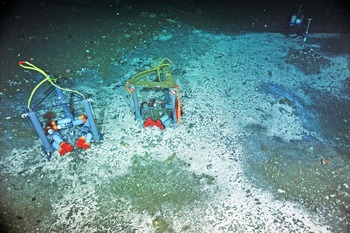Southern Hydrate Ridge

Methane is a powerful greenhouse gas and, therefore, quantifying the flux of methane from the seafloor into the hydrosphere is critical to understanding carbon-cycle dynamics and the impacts of global warming on methane release.

The digital still camera (CAMDSB103) sits atop a small, heavily sedimented rampart in front of the actively venting methane seep called Einstein's Grotto at the summit of Southern Hydrate Ridge. Photo credit: NSF-OOI/UW/CSSF; Dive R1767; V14.

A "Mosquito" flow meter (far left) and osmotic fluid sampler (far right) are installed in an active methane seep at Southern Hydrate Ridge. A second Mosquito, colonized by organisms, awaits recovery. These instruments provide fluid chemistry information, as well as calculations of fluid flow in and out of the seafloor. Photo credit: NSF-OOI/UW/CSSF; Dive R1772; V14.
Location: 44.6ºN 125.1ºW Water Depth: 780-771 meters
The Southern Hydrate Ridge study site (~10 km north of Primary Node PN1B) hosts abundant deposits of frozen methane (methane hydrates) that are buried beneath and exposed on the seafloor. The deposits vent methane-rich fluids and bubbles that escape through seeps on the seafloor. Dense and fascinating communities of microbes and animals are fueled by these escaping gases. Methane is a powerful greenhouse gas and, therefore, quantifying the flux of methane from the seafloor into the hydrosphere is critical to understanding carbon-cycle dynamics and the impacts of global warming on methane release.
Southern Hydrate Ridge is an important observatory site to define the temporal evolution of methane hydrate systems in response to seismic events. It is also an important area to quantify material fluxes from the seafloor and the impacts of methane release on overlying ocean chemistry. It provides an excellent opportunity to understand biogeochemical coupling associated with gas hydrate formation and destruction.
The real-time and interactive capabilities of the cabled observatory are critical to studying gas-hydrate systems because many of the key processes may occur over short time scales. Events such as bubble plume formation, the creation of collapse zones, and increased seepage in response to earthquakes will require adaptive response and sampling capabilities that include full-resolution sampling by upward-looking sonars, fluid and gas sampling, long-term duration collection of plume and seep imagery from cameras, and in situ manipulation of chemical sensors, which, coupled with flow meters, provide estimates of transient and more stable chemical flux.
During the UW-Cabled Array-OOI-NSF VISIONS'14 Expedition all infrastructure at this site was fully installed and became operational with live, real-time streaming of data to shore. The VISIONS'15 Cabled Array expedition was the first Operations and Maintenance cruise - all instruments are now operating at this site. Data from the short-period and broadband seismometers are accessible through IRIS.
The chemical, biological, and geophysical sensors that were installed and maintained at this site in 2014 and 2015 allow the first long-term, detailed investigation of the effects of seismic events on the release of hydrates and methane gas into the overlying ocean, and the changes in microbial and animal communities over time. An in situ camera, benthic flow sensors, and a mass spectrometer will allow investigation of how changes in fluid flow and chemistry impact the biological communities that thrive in this environment and quantification of the flux of methane from the seafloor.
Instruments now installed at this site include the the following:
3 Benthic Flow Sensors
1 Osmo Fluid Sampler
1 Broadband Seismometer with an accelerometer
1 Low-frequency Hydrophone
3 Short-period Seismometers
1 Mass Spectrometer
1 Digital Still Camera
1 Current Meter
1 Pressure Sensor

